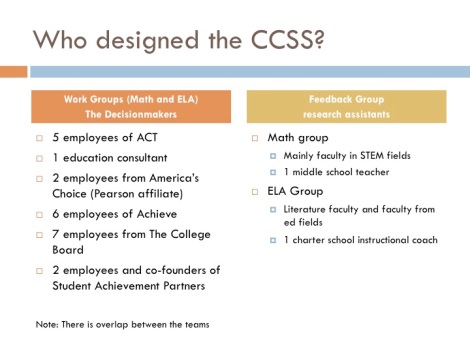Cloaking Inequity: Dewey, Testing Companies, and the Origin of the Common Core

The purported benefit of the Common Core State Standards over previous sets of standards is the development of critical thinking skills across all subjects, seen as a key lever for increasing American students’ international competitiveness and ameliorating the country’s lethargic economy and persistently high unemployment rates. This perception is clear in statements made by U.S. Secretary of Education Arne Duncan and in articles about the standards (Duncan, 2013; Garland, 2013). Billed as “reflecting the knowledge and skills that our young people need for success in college and careers” (NGA and CCSSO, 2010a). Will a set of standards actually prepare students for life and career?
John Dewey’s vision of reform was a bottom-up approach that focused on the needs of the child and the expertise of the teacher. He warned against a system that relied on a lack of connection between the people in charge of planning for education and the people in charge of actually educating. What would John Dewey think of the Common Core?
JulianVasquezHeilig
@ProfessorJVH
John Dewey on Common Core? @larryferlazzo @dianeravitch @arneduncan Shared via #Fotor
10:37 AM - 20 Oct 2014
In order to draw a fair conclusion about his potential response, it is worth more closely examining the design process of the Common Core. Explicit documentation of the process that lead to the Common Core State Standards is quite difficult to find. Information from National Governors Association (NGA) press releases indicates that the writing process occurred in two phases. In the first phase, math and language arts “development work groups” worked with respective “feedback groups” to research and write the standards. In the second phase, a “validation committee” reviewed and eventually certified a final product. Members of all groups were nominated by governors and chief state school officers (NGA, 2009a; NGA, 2009b).
Who was in those respective groups? All practicing teachers and school leaders of course…errrrr….

Note: Faculty in this slide represent university-level.
A press release explaining the roles of the groups makes very clear that the feedback group played “an advisory role, not a decision-making role in the process” (NGA, 2009a). Decision-making powers rested with the development work groups. These groups were made up almost entirely of employees of the non-profit organizations Student Achievement Partners and Achieve, and leaders at The College Board and ACT. Among the twenty-nine total members of the teams are three higher education faculty members and one principal (NGA, 2009a).
The feedback group “[provided] information backed by research to inform the standards development process by offering expert input on draft documents” (NGA, 2009a). Members of that group were mainly university faculty from various departments along with one teacher, one charter school instructional coach, and one president of an education non-profit. The “validation committee,” that reviewed and certified the final product. Here in this final step was where teachers, administrators, and many teacher educators could be found. Their role was to verify that each standard was indeed supported by enough research – research on college and career readiness – to warrant inclusion. This group also had the opportunity to add standards provided that they could prove that they were sufficiently research-based. Or to
The lower-level groups represent some experts in academic fields and some knowledge of the classroom, but these people were not leaders in the process. A look into the organizations represented by the development work group – those in control of the process – will give a better sense of the priorities driving the standards. Pearson, The College Board and ACT are probably known to the reader as companies that design standardized tests and test-preparation materials. Student Achievement Partners and Achieve are likely less familiar even though both played central roles in the development of the Common Core State Standards. In fact, their involvement continues in the ongoing implementation process.
Achieve bills itself as a coordinator of sorts and was “founded at the National Education Summit by leading governors and business leaders” (Achieve, Inc., n.d.a) in 1996. Their work is to bring legislators, policy makers, governors, and education and business leaders in the states together to work on solutions to perceived problems. Achieve was part of the leadership in creating the Common Core State Standards and is currently leading one of two efforts to design assessments aligned to the standards. Achieve’s main donors are corporate foundations and private industry companies including many companies rumored to be contributors to the American Legislative Exchange Council (See more Smart ALEC: Education, Privatization, and the Pursuit of Profit and Update on Smart ALEC: Education, Privatization, and the Pursuit of Profit). This is important because it perhaps indicates that Achieve represents the interests of politicians and the private sector, not necessarily students. (Achieve, Inc., n.d.b; Center for Media and Democracy, 2013)
Student Achievement Partners was founded by David Coleman, Jason Zimba, and Susan Pimentel – often named in the media as architects or lead writers of the Common Core. Student Achievement Partners is dedicated solely to implementation of the standards. They have created instructional materials that are offered to educators free of charge through their website and are participating in the design of teacher evaluation tools. Some of their staff members conduct professional development sessions in schools around the country. We do acknowledge that some of these staff members may have had past classroom teaching experience and participated in the creation of the standards through their roles at Student Achievement Partners (Student Achievement Partners, n.d.).
Despite the presence of current educators in some phases of the development of the Common Core, it seems clear that the develop of the standards was external to current classroom educators and school leaders. Testing companies and their affiliates clearly had an outsized role in their development. John Dewey advocated for bottom-up school and school system design grounded in classroom and what was known about the development and interests of children. However, based on the affiliations and interests of the primary developers of Common Core, its development was a top-down approach that clearly reflects the priorities of people in power – testing companies, governors, policy makers, corporations and foundations of great means— but is being sold as Deweyan critical thinking. But is the opposite of Deweyan student and teacher emancipation. So it appears that the Common Core standard development process was not reform, just business as usual. See also Common Core: Same Exclusion, Different Century and Taylor v. Dewey: The 100-year Trickle-Down vs. Pedagogical Debate/Fight in Education Reform
This post is primarily the work and analysis conducted by R. D’Angelo and R. Sanchez
Please Facebook Like, Tweet, etc below and/or reblog to share this discussion with others.
Want to know about Cloaking Inequity’s freshly pressed conversations about educational policy? Click the “Follow blog by email” button in the upper left hand corner of this page.
Twitter: @ProfessorJVH
Click here for Vitae.
Please blame the non-educators who designed the Common Core for any typos. :)
Interested in joining us in the sunny capitol of California and obtaining your Doctorate in Educational Leadership from California State University Sacramento? Apply by March 1. Go here.
Relevant References
Achieve, Inc. (n.d.a). About us. Retrieved from http://www.achieve.org/about-us.
Achieve, Inc. (n.d.b). Our contributors. Retrieved from http://www.achieve.org/contributors.
C Burris, & V Strauss. (2013, October 31). A ridiculous common core test for first graders [Web log comment]. Retrieved from http://www.washingtonpost.com/blogs/answer-sheet/wp/2013/10/31/a-ridiculous-common-core-test-for-first-graders/.
Center for Media and Democracy. (2013). ALEC corporations. Retrieved from http://www.sourcewatch.org/index.php?title=ALEC_Corporations
Cremin, L. A. (1961). The transformation of the school: Progressivism in American education, 1876-1957 (Vol. 519). New York: Knopf.
Dewey, John. (1983). The classroom teacher. In J.A. Boydston and A. Sharpe (Eds.), John Dewey: The middle works, 1899-1924 (Vol. 15, pp. 180-189). Carbondale and Edwardsville: Southern Illinois University Press.
Dewey, John. (1990). The school and society and the child and the curriculum. Chicago and London: The University of Chicago Press.
Dewey, John. (2010a). My pedagogic creed. In Douglas J. Simpson and Sam F. Stack (Eds.) Teachers, leaders, and schools: Essays by John Dewey (pp. 24-32). Carbondale and Edwardsville: Southern Illinois University Press.
Dewey, John. (2010b). The teacher and the public. In Douglas J. Simpson and Sam F. Stack (Eds.) Teachers, leaders, and schools: Essays by John Dewey (pp. 241-244). Carbondale and Edwardsville: Southern Illinois University Press.
Duncan, Arne. (2013). Remarks at the American Society of News Editors Annual Convention [Speech transcript]. Retrieved from http://www.ed.gov/news/speeches/duncan-pushes-back-attacks-common-core-standards
Garland, S. (2013, October 6). Why the common core? The Huffington Post. Retrieved from http://www.huffingtonpost.com/2013/10/15/why-common-core_n_4102763.html
Kliebard, Herbert M. (2004). The struggle for the American curriculum: 1893-1958 (3rd ed.). New York and London: Routledge Falmer.
NGA National Governors Association. (2009a). Common core state standards development work group and feedback group announced [Press release]. Retrieved from http://www.nga.org/cms/home/news-room/news-releases/page_2009/col2-content/main-content-list/title_common-core-state-standards-development-work-group-and-feedback-group-announced.html.
NGA National Governors Association Center for Best Practices and the Council of Chief State School Officers. (2009b). Common core state standards initiative validation committee announced [Press release]. Retrieved from http://www.nga.org/cms/home/news-room/news-releases/page_2009/col2-content/main-content-list/title_common-core-state-standards-initiative-validation-committee-announced.html
National Governors Association Center for Best Practices and the Council of Chief State School Officers. (2010a). Common core state standards. Washington, D.C.: National Governors Association Center for Best Practices and the Council of Chief State School Officers. Retrieved from http://www.corestandards.org.
NGA National Governors Association. (2012a). Governors work to implement the common core state standards. Retrieved from http://www.nga.org/cms/home/news-room/news-releases/page_2012/col2-content/governors-work-to-implement-the.html.
NGA National Governors Association. (2012b). Trends in state implementation of the common core state standards: Educator effectiveness [PDF document]. Retrieved from http://www.nga.org/cms/home/nga-center-for-best-practices/center-publications/page-edu-publications/col2-content/main-content-list/trends-in-state-implementation-o.html.
NGA National Governors Association. (n.d.). Common core state standards initiative standards-setting criteria [PDF document]. Retrieved from http://www.corestandards.org/assets/Criteria.pdf.
NCEE National Commission on Excellence in Education (1983). A nation at risk. Retrieved from http://www2.ed.gov/pubs/NatAtRisk/index.html.
Ravitch, Diane. (1995). National standards in American education: A citizen’s guide. Washington, D.C.: The Brookings Institution.
Ravitch, Diane. (2010). The death and life of the great American school system: How testing and choice are undermining education. New York: Basic Books.
Simpson, Douglas J., & Stack, Sam F. (Eds.). (2010). Teachers, leaders, and schools: Essays by John Dewey. Carbondale, IL: Southern Illinois University Press.
Student Achievement Partners. (n.d.) Principles and purpose. Retrieved from http://www.achievethecore.org/about-us
United States Department of Education (2001). No child left behind executive summary.
Retrieved from http://www2.ed.gov/nclb/overview/intro/execsumm.html.
United States Department of Education (2009). Race to the top executive summary.
Retrieved from http://www2.ed.gov/programs/racetothetop/executive-summary.pdf.
United States Congress, 103rd Congress. (1994). H.R. 6 Improving America’s schools act, section 1111: state plans. Retrieved from http://www2.ed.gov/legislation/ESEA/sec1111.html.
McNeil, L., & Valenzuela, A. (2001). The harmful impact of the TAAS system of testing in Texas: Beneath the accountability rhetoric. In M. Kornhaber & G. Orfield (Eds.), Raising standards or raising barriers? Inequality and high stakes testing in public education (pp. 127-150). New York: Century Foundation.
Vasquez Heilig, J. & Nichols, S. (2013). A quandary for school leaders: Equity, high-stakes testing and accountability. In L. C. Tillman & J. J. Scheurich (Eds.), Handbook of research on educational leadership for diversity and equity, New York: Routledge.
Vasquez Heilig, J., & Darling-Hammond, L. (2008). Accountability Texas-style: The progress and learning of urban minority students in a high-stakes testing context. Educational evaluation and policy analysis, 30(2), 75–110.
Vinovskis, Maris A. (2009). From a nation at risk to no child left behind: National education goals and the creation of federal education policy. New York and London: Teachers College Press.
This blog post has been shared by permission from the author.
Readers wishing to comment on the content are encouraged to do so via the link to the original post.
Find the original post here:
The views expressed by the blogger are not necessarily those of NEPC.

